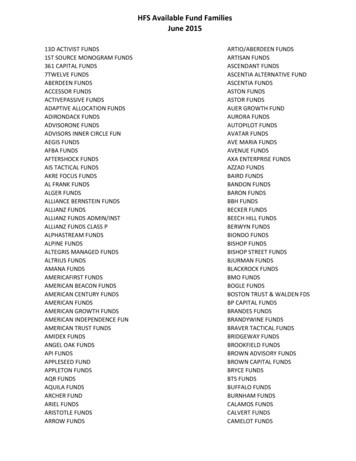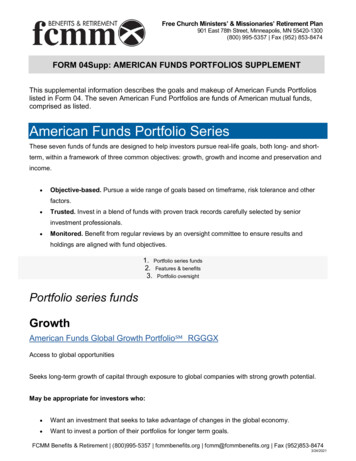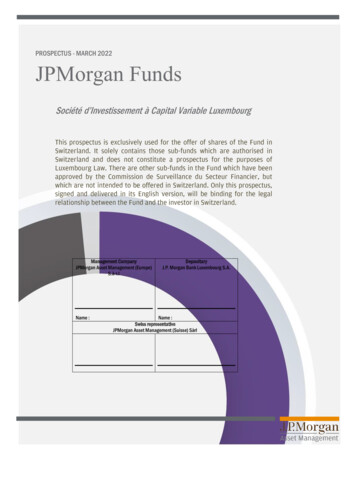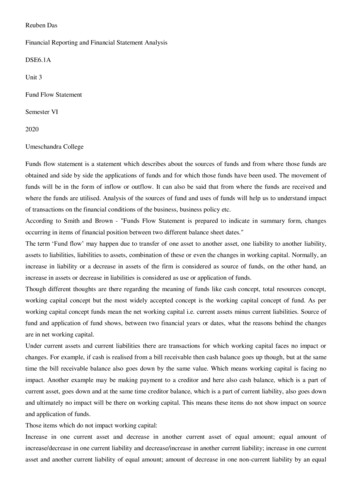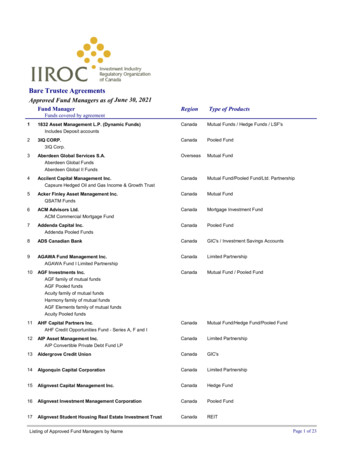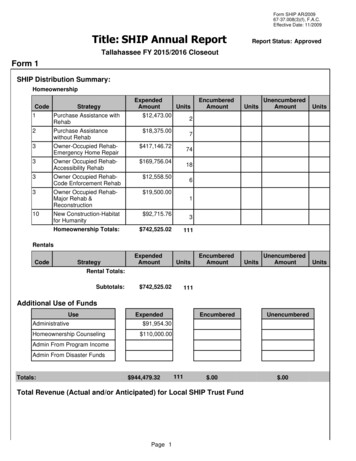
Transcription
Financial Management SeriesData AnalysisAugust 5, 2010
Series Agenda Session 1: Organizational Systems and Controls Internal controls and compliance, financial infrastructure,reporting systems Session 2: Data Analysis Interpreting financial statements, financial ratios and financialdashboards Session 3: Finance Team Financial competency and roles and responsibilities
Partners Kate Sphar, Dewey & Kaye Scott Leff, Bayer Center for NonprofitManagement at Robert Morris University Linda Dickerson, 501c(3)
www.forbesfunds.org
www.forbesfunds.org
www.forbesfunds.org
Session 2Data Analysis Interpreting Financial Statements Financial Ratios Financial Dashboards
Interpreting Financial Statements Where should I look first to determine ourimmediate financial strengths andvulnerabilities? Balance Sheet Budget vs. Actual Statement Cash Flow Projections
Balance Sheet
Balance Sheet Current Assets How many months of cash do we have on hand? Are there any receivables that we should be collecting now? Fixed and Long-term Assets What is the value of our long-term and/or fixed assets? What is the cost to us for maintaining these assets? Are we generating appropriate revenue from our long-termassets?
Balance Sheet Current Liabilities Do we have enough current assets to cover our currentliabilities? Are we paying our bills in a timely manner? What commitments must we meet for any deferred liabilities? Net Assets What is the net worth we have built in our organization? Do our assets exceed our liabilities by a solid margin?
Budget vs. Actual Statement
Budget vs. Actual Statement Best Practices Compare YTD budget with YTD actual Show variance between figures Include variance as a percentage of budget Include full-year budget as a point of reference
Budget vs. Actual Statement Key Questions What is our bottom line? What line items account for the variance from our budget? What is the reason for the line item variance? Do we need to make adjustments moving forward?
Cash Flow Projections
Cash Flow Projections Best Practices At least six months of projections Include beginning cash balance from bank statement orbalance sheet Conservative income estimates – what are we reasonablycertain will come in? Can produce multiple scenarios based on income andexpense variance (best case, most likely case, worst case)
Cash Flow Projections Key Questions How certain are we of our revenue and expense projections? Do we have ample cash reserves to cover negative cashflow? If not, what preparations or adjustments do we need tomake?
Additional Reports Program statements (program budget vs.actual) Cash flow statement (historical) Company dashboard
Discussion Questions Is the information in our financial statements andprojections clear, reliable and easy to understand? How can we improve our financial statements to give usthe information that we need? Does the information in our financial statements raiseany red flags? If so, what do we need to do to addressthem?
Financial Ratios Context Trends Comparison to competitors Comparison to sector (mission) benchmarks Internal goal-setting
Financial Ratios
Financial Ratios Liquidity Solvency Profitability Funding Diversification
Financial Ratios Liquidity Ratio Days Cash on Hand (Unrestricted Cash and Equivalents x365) / (Total Operating Expenses – Annual Depreciation)Explanation: This tells how long, in days, the organization could meetoperating expenses without receiving any additional revenue. It is helpful tocompare your current figure to past values as well as to other similarorganizations. Organizations typically strive to maintain at least 90 - 180days cash on hand.In some cases, it is appropriate to include "Investments" in the numeratorbecause these assets can be converted into cash fairly quickly. Also, thenumerator should only include unrestricted funds.
Financial Ratios Solvency Ratio Operating Reserves Ratio Unrestricted Net Assets / TotalExpensesExplanation: This ratio shows the percent of available operating funds (the'equity' in a nonprofit agency) that an organization maintains to coversignificant unbudgeted increases in operating expenses or losses inrevenues. Operating Reserves can serve as an internal line of credit whenneeded to cover the normal fluctuations of day-to-day operations. If low, theorganization has little unrestricted, spendable “equity” to meet temporarycash shortages, an emergency, or a deficit situation in the future.
Financial Ratios Profitability ratio Savings Ratio (Total Revenues – Total Expenses) / TotalExpensesExplanation: This ratio measures the ability of an organization to add toits net assets. Positive values indicate an increase in savings. Thesavings ratio is a simple way to determine if an organization is adding toor using up its net asset base.
Financial Ratios Funding Diversity Ratio Contributed Revenue Ratio (Contributions Net SpecialEvents Revenue) / Total RevenuesExplanation: This ratio measures the composition of funds derived fromcontributions and special events, net of expenses, relative to totalrevenues. It is useful for observing both long and short-term trends aswell as for setting strategic goals.
Financial RatiosWhat are your ratios?
Financial DashboardsIs this how your Board looksduring the presentation offinancial reports?.
Financial DashboardsWith a financial dashboard, You can turn this To this
Financial DashboardsOr, more to the point, From this To this
Financial Dashboards Clarity Focus Effective use of Board skills Governance Strategy Vision.Not micromanagement!
WhatwillyouputonyourDashboard?
Session 2Data AnalysisQuestions?
Thank You! Staci Brogan, Schneider Downs Garrett Cooper, Bayer Center for Nonprofit Management,at Robert Morris University Lauri Fink, Hillman Foundation Jordan Pallitto, The Hill Group Karen Ranick, KFMR Scott Rogerson, The Hill Group Shawn Sheridan, Dewey & Kaye JW Wallace, Independent Consultant Mike Welsh, McCrory & McDowell
Next SessionFinance Team Roles and ResponsibilitiesAugust 19, 2010
Financial Ratios Profitability ratio Savings Ratio (Total Revenues - Total Expenses) / Total Expenses Explanation: This ratio measures the ability of an organization to add to its net assets. Positive values indicate an increase in savings. The savings ratio is a simple way to determine if an organization is adding to


